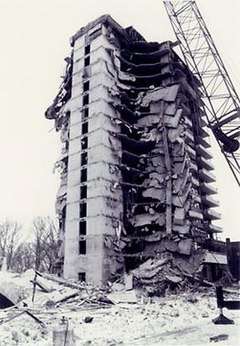2000 Commonwealth Avenue collapse
On January 25, 1971, a luxury condominium building under construction at 2000 Commonwealth Avenue in Brighton, Boston, Massachusetts, collapsed, killing 4 construction workers and injuring 30 others.[1][2][3]
 Building after collapse | |
| Date | January 25, 1971 |
|---|---|
| Location | Brighton, Boston, Massachusetts |
| Coordinates | 42.33946°N 71.15859°W |
| Cause | Building collapse due to lack of shoring and low concrete strength |
| Outcome | 4 construction workers killed, 30 injured |
History
The construction of the 2000 Commonwealth Avenue building began in autumn 1969. The building that collapsed was to have contained 133 condominium apartments.[1] The collapse occurred the day before the building's scheduled "top out" day.[4]
Collapse
The building collapsed while concrete was being poured on the top floor of the building.[4] Two-thirds of the building was destroyed by a progressive collapse. Approximately 100 men were working in or around the building.[1]
A difficult and dangerous search by rescue workers, involving days of digging, led to the recovery from the building's basement of the bodies of the four workers who died in the collapse.[1][3] The search was postponed for 36 hours while the Boston building commissioner and other experts confirmed the stability of the remaining structure, a delay that angered the coworkers and family members of the missing men.[5]
The four workers killed were:
- Ciraco DiIorio, 45, laborer, from Roslindale, Boston, Massachusetts
- Michael Papasedero, 27, foreman, from Dedham, Massachusetts
- Daniel Tintindo, 41, welder, from Mansfield, Massachusetts
- James Cingolani, 26, Tintindo's helper, from Quincy, Massachusetts[3][5][6]
Papasedero was last seen after the collapse had begun entering the basement garage, where Tintindo and Cingolani, members of his crew, had been working, to search for them.[3]
Cause
Contributory causes of the collapse included lack of quality control and inspections, concrete weakened when left unprotected from cold weather, deficiencies in shoring and reinforcing bars and overly high construction loads on the roof slab. A commission of inquiry concluded that the primary causes of the collapse were lack of shoring and low concrete strength.[1] On July 23, 1972, Controlled Demolition, Inc., imploded the unfinished building after the completion of the recovery effort.[7]
References
- King, S., and Delatte, N. (2004). "Collapse of 2000 Commonwealth Avenue: Punching Shear Case Study." J.Perform.Constr.Facil., 18(1), 54-61.
- Daley, Beth (July 17, 2006). "Back to the drawing board: When structures fail, anything can be to blame, from bolts to bad management". The Boston Globe. Retrieved October 18, 2018.
- Pletcher, Larry (2017). "Sixteen-Story Rescue: Building Collapse in Brighton (1971)". Massachusetts Disasters: True Stories of Tragedy and Survival. With additional stories by David J. Krajicek. Guilford, Connecticut: Globe Pequot. pp. 176–183. ISBN 978-1-4930-2876-4.
- Pletcher, p. 177.
- Bellon, Bernard (8 February 1971). "Collapse darkens dorm". The Heights. LI (16). Retrieved October 23, 2018.
- UPI (February 2, 1971). "Continue body hunt in Boston rubble". The Lowell Sun. p. 35. Retrieved October 23, 2018.
- "2000 Commonwealth Avenue". Controlled Demolition, Inc. Retrieved October 22, 2018.
Further reading
- "2000 Commonwealth Avenue, Boston". Failure Case Studies. University of North Carolina at Charlotte. 2013. Retrieved October 22, 2018.